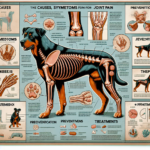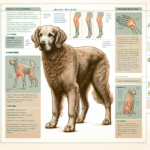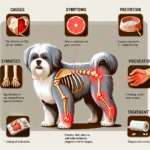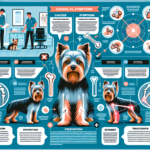Barbet Joint Pain: Causes, Symptoms, Prevention, and Treatment
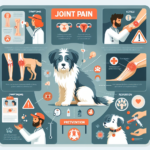
Introduction
The Barbet, a rare and ancient French water dog, is known for its distinctive curly coat and friendly demeanor. Historically, the Barbet was bred for hunting waterfowl, and its name is derived from the French word “barbe,” meaning beard, a reference to its characteristic facial hair. This breed is medium-sized, with a robust and muscular build, making it well-suited for its original purpose of retrieving game from water. Today, the Barbet is cherished as a versatile companion, excelling in various canine sports and activities.
Like many breeds, the Barbet is prone to certain health issues, with joint pain being a significant concern. Joint health is crucial for maintaining the Barbet’s active lifestyle and overall well-being. Understanding the causes, symptoms, prevention, and treatment of joint pain in Barbets can help owners ensure their pets lead healthy, pain-free lives.
Breed-Specific Joint Pain Risks
Genetic Predisposition
Barbets, like many purebred dogs, have a genetic predisposition to joint-related issues. Common conditions include hip dysplasia, elbow dysplasia, and arthritis. Hip dysplasia occurs when the hip joint doesn’t fit together perfectly, leading to wear and tear. Elbow dysplasia involves abnormal development of the elbow joint, causing pain and lameness. Arthritis, a degenerative joint disease, can develop as a secondary condition to these dysplasias or independently as the dog ages.
Age-Related Risks
As Barbets age, the risk of joint pain increases. While young Barbets may show early signs of joint issues due to genetic factors, older dogs are more likely to develop arthritis and other degenerative joint conditions. Owners should be vigilant about joint health as their Barbet reaches middle age, typically around 5-7 years, and continue monitoring into their senior years.
Activity Level and Joint Stress
The Barbet’s high energy levels and love for physical activities can contribute to joint stress. Whether participating in agility, obedience, or simply enjoying long walks and play sessions, the constant movement can strain their joints. While exercise is essential for maintaining overall health, it’s crucial to balance activity levels to prevent overexertion and joint damage.
Common Symptoms of Joint Pain in Barbets
General Symptoms
- Limping: One of the most noticeable signs of joint pain is limping or favoring one leg.
- Stiffness: Difficulty in getting up or lying down, especially after rest, can indicate joint pain.
- Reluctance to Move: A Barbet may be less willing to jump, climb stairs, or engage in physical activities they once enjoyed.
- Swelling: Visible swelling around the joints can be a sign of inflammation.
- Behavioral Changes: Increased irritability or changes in behavior may be due to chronic pain.
Breed-Specific Symptoms
In Barbets, joint pain may manifest as a reluctance to swim or retrieve, activities they typically enjoy. Owners might also notice a decrease in their dog’s enthusiasm for long walks or play sessions. Given the breed’s history as a working dog, any reduction in activity levels should be taken seriously.
When to Consult a Vet
If a Barbet shows any signs of joint pain, it’s essential to consult a veterinarian promptly. Early intervention can prevent further deterioration and improve the dog’s quality of life. Persistent limping, noticeable stiffness, or any significant change in behavior warrants a professional evaluation.
Preventive Measures for Joint Health
Exercise Recommendations
Regular, moderate exercise is crucial for maintaining joint health in Barbets. Activities like swimming are excellent as they provide a full-body workout without putting excessive strain on the joints. Short, frequent walks and controlled play sessions can also help keep the joints flexible and muscles strong. Avoid high-impact activities like jumping or running on hard surfaces, which can exacerbate joint issues.
Dietary Suggestions
A balanced diet rich in essential nutrients supports joint health. Foods containing glucosamine and chondroitin can help maintain cartilage health. Omega-3 fatty acids, found in fish oil, have anti-inflammatory properties that can alleviate joint pain. Owners should consult their veterinarian for specific dietary recommendations and consider supplements if necessary.
Weight Management
Maintaining a healthy weight is vital for reducing joint stress. Excess weight puts additional pressure on the joints, exacerbating pain and accelerating degeneration. Owners should monitor their Barbet’s weight and adjust their diet and exercise routine to prevent obesity. Regular weigh-ins and body condition assessments can help keep the dog at an optimal weight.
Early Screening and Monitoring
Early screening for joint issues can catch problems before they become severe. Regular veterinary check-ups should include joint assessments, especially as the Barbet ages. X-rays and other diagnostic tools can help identify early signs of dysplasia or arthritis. Early intervention strategies, such as physical therapy or lifestyle adjustments, can then be implemented to manage the condition.
Treatment Options for Joint Pain
Non-Surgical Treatments
Non-surgical treatments for joint pain in Barbets include medications, physical therapy, and lifestyle adjustments. Anti-inflammatory drugs and pain relievers can provide immediate relief. Physical therapy, including exercises and hydrotherapy, can strengthen muscles and improve joint function. Lifestyle adjustments, such as modifying exercise routines and providing supportive bedding, can also alleviate pain.
Surgical Options
In severe cases, surgical intervention may be necessary. Common surgeries for joint pain include hip replacement, elbow arthroscopy, and joint fusion. These procedures can significantly improve the dog’s quality of life but come with risks and require a lengthy recovery period. Owners should discuss the potential benefits and drawbacks with their veterinarian to make an informed decision.
Alternative Therapies
Alternative therapies like acupuncture, hydrotherapy, and massage can complement traditional treatments. Acupuncture can reduce pain and inflammation, while hydrotherapy provides low-impact exercise that strengthens muscles without stressing the joints. Massage therapy can improve circulation and reduce muscle tension, providing relief from chronic pain.
Lifestyle and Management Tips
Daily Care Routine
A daily care routine for a Barbet with joint pain should include gentle exercise, a balanced diet, and regular monitoring. Short, frequent walks and swimming sessions can keep the dog active without overexerting their joints. Providing a diet rich in joint-supporting nutrients and maintaining a healthy weight are also crucial. Regular check-ups with the veterinarian can help monitor the condition and adjust the care plan as needed.
Modifying the Home Environment
Making the home environment more comfortable can significantly improve a Barbet’s quality of life. Installing ramps or steps can help the dog navigate furniture and stairs without jumping. Orthopedic beds provide better support for aching joints, and non-slip mats can prevent falls on slippery surfaces. Ensuring easy access to food, water, and favorite resting spots can also reduce strain on the joints.
Long-Term Management
Long-term management of joint pain involves a combination of regular veterinary care, appropriate exercise, a balanced diet, and a supportive home environment. Owners should remain vigilant for any changes in their dog’s condition and adjust the care plan as needed. Consistent monitoring and proactive management can help keep the Barbet active and happy despite joint pain.
FAQs About Barbets and Joint Pain
What are the early signs of joint pain in Barbets?
Early signs of joint pain in Barbets include limping, stiffness, reluctance to move, and behavioral changes. Owners should watch for these symptoms and consult a veterinarian if they notice any of them.
Can joint pain in Barbets be prevented?
While genetic predispositions cannot be entirely prevented, maintaining a healthy weight, providing a balanced diet, and ensuring regular, moderate exercise can reduce the risk of joint pain. Early screening and monitoring can also help catch issues before they become severe.
Are there specific exercises that are better for Barbets with joint pain?
Low-impact exercises like swimming and short, frequent walks are ideal for Barbets with joint pain. These activities provide a good workout without putting excessive strain on the joints.
What dietary supplements can help with joint pain in Barbets?
Supplements containing glucosamine, chondroitin, and omega-3 fatty acids can support joint health and reduce inflammation. Owners should consult their veterinarian for specific recommendations.
When should I consider surgery for my Barbet’s joint pain?
Surgery should be considered when non-surgical treatments no longer provide relief, and the dog’s quality of life is significantly affected. A veterinarian can help determine if surgery is the best option based on the severity of the condition and the dog’s overall health.
Conclusion
Joint pain is a significant concern for Barbets, but with proper care and management, owners can help their dogs lead active, pain-free lives. Understanding the breed-specific risks, recognizing early symptoms, and implementing preventive measures are crucial steps in maintaining joint health. Regular veterinary check-ups, a balanced diet, appropriate exercise, and a supportive home environment can all contribute to a Barbet’s well-being. By taking proactive steps and consulting with their veterinarian, owners can ensure their beloved pets enjoy a high quality of life despite the challenges of joint pain.

